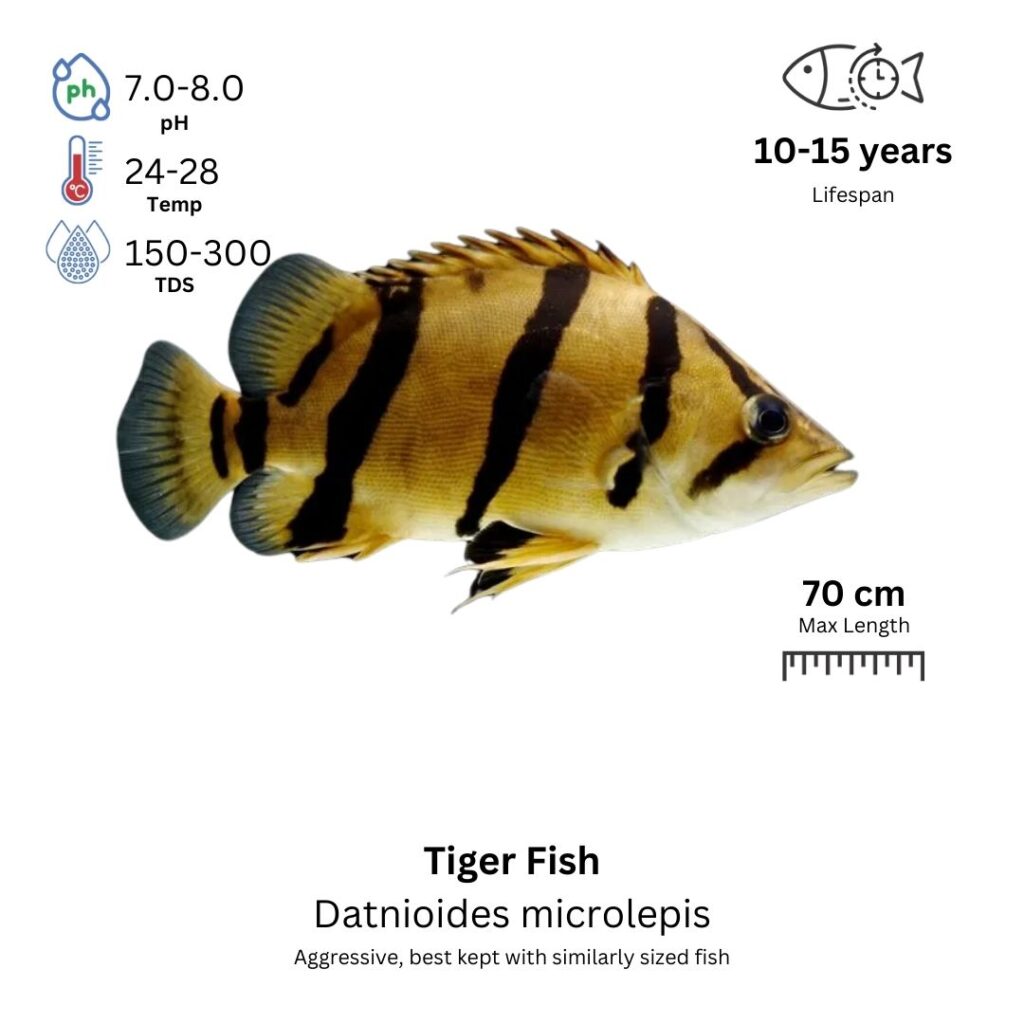Tiger Fish
Datnioides microlepis

Description
The Tiger Fish is a predatory species known for its striking appearance and formidable hunting skills. It has an elongated, sleek body that is covered in silver scales with a characteristic pattern of dark vertical stripes, resembling the stripes of a tiger. The sharp, pointed teeth are another notable feature, along with its large mouth that is perfectly adapted for catching prey. Its fins are well-developed, with long pectoral fins and a large, forked tail that aids in fast swimming. Tiger Fish are aggressive hunters, preying on smaller fish, and they are known for their lightning-fast strikes. They are territorial and require ample space to establish their hunting grounds.
Habitat Origin
Tiger Fish are native to Africa, primarily found in the Congo River Basin, the Nile River, and other large rivers and lakes in Central and Eastern Africa. These rivers have fast-moving currents and are rich in fish life, making them an ideal environment for the Tiger Fish to hunt. The species prefers warm, oxygenated water and is commonly found in areas with abundant submerged structures and clear water.
Aquarium
Ideal Number in Aquarium: Best kept singly or in pairs, as they are territorial and may not get along with other tiger fish in confined spaces.
Favorite Food

Tiger Fish are carnivores and will eat a variety of live or frozen foods. They prefer whole fish, large invertebrates, and can also accept pellets designed for carnivorous fish. In captivity, they can be fed live fish, small amphibians, or large invertebrates like shrimp and crabs. Their sharp teeth are perfectly suited for catching and tearing into prey. A diet rich in protein is essential for keeping the Tiger Fish healthy and active.
Behavior:
Tiger Fish are aggressive, territorial, and fast swimmers. They are nocturnal hunters, often becoming more active during the evening or night when they hunt. During the day, they may rest in a secluded spot or hide in aquarium decorations. While they are generally peaceful with larger, equally strong fish, they may become territorial and chase or attack smaller fish that encroach on their space. They are best kept with other large, robust fish species and should be housed in spacious aquariums where they can establish and defend their territory.
Special Care:
Tiger Fish require stable water conditions, with regular water changes to maintain high water quality. They thrive in well-oxygenated water with moderate flow, mimicking the fast-moving rivers of their natural habitat. Their tank should have plenty of hiding spots, like rocks and plants, where they can retreat when not hunting. Because of their aggressive and predatory nature, they should be housed with larger, similarly aggressive or large predatory species. Small fish or slow-moving tankmates are not suitable due to the Tiger Fish’s hunting instincts.
Compatibility with Other Fish:
No, Tiger Fish are not suitable for community aquariums with smaller, peaceful fish. They are predatory and will view smaller fish as food. They are best kept with large, robust species that can tolerate their aggression. Suitable tankmates include other large carnivorous fish, such as large cichlids, arowanas, or large catfish. Keeping them in a species-specific tank or with other large, aggressive fish is recommended to avoid conflicts and ensure their well-being.
Breeding Setup
Use a separate breeding tank of at least 300 liters (79 gallons) to manage water quality, temperature, and reduce predation risks. Tiger Fish are large, territorial, and need ample space to swim and exhibit natural behaviors. Maintain water parameters at pH 6.5–7.5, temperature 26–30°C, and GH 6–12 dGH. Use a strong, adjustable-flow filtration system like a canister filter to keep water clean but avoid excessive current that stresses the fish. Substrate and plants aren’t necessary, but add smooth rocks or stable decorations to mimic their natural habitat and create territories. Use moderate lighting to simulate dappled sunlight.
Conditioning for Breeding
Feed a high-protein diet: live foods (small fish, brine shrimp, worms, crickets), quality carnivorous pellets, and frozen options (mysis shrimp, bloodworms). Perform regular 25% weekly water changes to maintain optimal water quality and condition the fish for spawning.
Spawning
Tiger Fish are egg layers that spawn in natural settings during seasonal floods or temperature shifts. In captivity, mimicking these conditions helps induce spawning. Females can lay thousands of sticky eggs on submerged surfaces like rocks or plants. Remove adults after spawning to prevent egg predation, as Tiger Fish may eat their own eggs.
Fry Care
Eggs hatch in 48–72 hours depending on temperature. Fry remain near the egg site initially and later become free-swimming. Feed newly hatched fry infusoria or liquid fry food, transitioning after a few days to baby brine shrimp and finely crushed pellets. Maintain excellent water quality with small daily water changes (10–15%), stable temperature (26–30°C), and protect fry from aggression.
Important Notes
Tiger Fish mature sexually at 2 to 3 years. Males tend to be smaller with longer, more colorful fins during breeding, while females are larger and rounder when carrying eggs. Minimize stress by providing plenty of hiding places and territories, avoiding overcrowding, and removing aggressive tankmates to ensure a peaceful environment for breeding.
